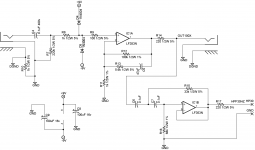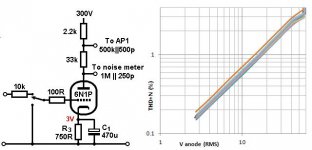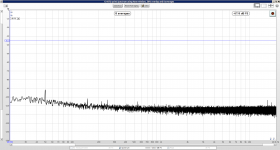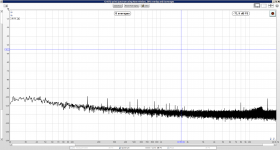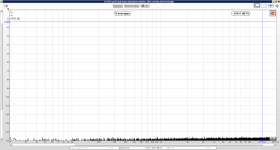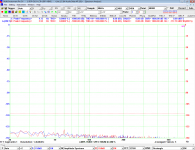All of the VFD based products I've owned have faded after about a ten years. My Microwave which I replace recently was only visible at night with the lights off. That said, 10 years is 87,600 hours of continuous operation.
Hi Everyone,
I updated the list of measurements on my "downloads" page with additional samples of the Sovtek 6H9C/6SL7GT. These continue to be very low noise tubes, among the lowest noise of the conventional audio tubes on my list, with input-referred noise around 0.57 uV RMS.
I've read online that although they are branded Sovtek, they are not produced in the Reflektor factory, but are NOS Soviet-era tubes. At any rate, from an intrinsic noise standpoint they outperform the Tung Sol Reissue 6SL7GT, which I believe is Reflektor-produced.
Scott
I updated the list of measurements on my "downloads" page with additional samples of the Sovtek 6H9C/6SL7GT. These continue to be very low noise tubes, among the lowest noise of the conventional audio tubes on my list, with input-referred noise around 0.57 uV RMS.
I've read online that although they are branded Sovtek, they are not produced in the Reflektor factory, but are NOS Soviet-era tubes. At any rate, from an intrinsic noise standpoint they outperform the Tung Sol Reissue 6SL7GT, which I believe is Reflektor-produced.
Scott
It has been a while, but I just updated the list of tube noise measurements on the "downloads" page of our website. No new tube types, but many additional samples of the JJ 5751, Tung Sol Reissue 6SL7GT, and Sovtek 6H9C/6SL7GT.
The last several batches of JJ 5751 have not been quite so low noise as the early ones, but this is still the lowest noise 12AX7 type I'm aware of.
The last batch of Tung Sol Reissue 6SL7GT had some very low noise samples, which improved the average for this type a bit.
And the Sovtek 6H9C/6SL7GT continues to be a very consistent and low noise tube.
Best,
Scott
The last several batches of JJ 5751 have not been quite so low noise as the early ones, but this is still the lowest noise 12AX7 type I'm aware of.
The last batch of Tung Sol Reissue 6SL7GT had some very low noise samples, which improved the average for this type a bit.
And the Sovtek 6H9C/6SL7GT continues to be a very consistent and low noise tube.
Best,
Scott
May be "belt and suspenders" -- you might want to put a little incandescent bulb in series with the 0.1uF cap in your noise measurement amplifier. This will add almost nothing to noise but put a big brake on inrush current.
OR you could do, a la Tektronix in their differential amplifiers, add a "pre-charge" push button.
I've fried quite a few opamps trying to measure noise in HV stages. And of course, a "sacrificial" opamp is a lot cheaper than getting the front-end of your analyzer repaired.
OR you could do, a la Tektronix in their differential amplifiers, add a "pre-charge" push button.
I've fried quite a few opamps trying to measure noise in HV stages. And of course, a "sacrificial" opamp is a lot cheaper than getting the front-end of your analyzer repaired.
Hi Jack,
It's good to hear from you. Is this the circuit you're referring to? That's the purpose of the 1000 ohm resistor, the clamp diodes, and the 100 ohm resistor. I think it would be hard to damage the opamp with all those protections.....
Best, Scott
It's good to hear from you. Is this the circuit you're referring to? That's the purpose of the 1000 ohm resistor, the clamp diodes, and the 100 ohm resistor. I think it would be hard to damage the opamp with all those protections.....
Best, Scott
Attachments
by the way
A friend reports great subjective results from a pair per channel of 6C45 as an MC stepup. No semiconductors in the signal chain, buncha inductors and transformers.
I hope to hear the results sometime fairly soon.
A friend reports great subjective results from a pair per channel of 6C45 as an MC stepup. No semiconductors in the signal chain, buncha inductors and transformers.
I hope to hear the results sometime fairly soon.
Hi,
That's very interesting. I assume the inductors serve as plate loads ?
Cheers, 😉
A friend reports great subjective results from a pair per channel of 6C45 as an MC stepup
That's very interesting. I assume the inductors serve as plate loads ?
Cheers, 😉
In case anyone is interested, here are some noise and distortion results for ten 6N1P triodes I measured.
Average voltage gain was 27 (28.6dB).
Miller capacitance was around 82pF.
EIN (21Hz to 23kHz):
Sample 1: 0.74uV
Sample 2: 0.96uV
Sample 3: 0.91uV
Sample 4: 1.17uV
Sample 5: 1.07uV
Sample 6: 0.81uV
Sample 7: 1.97uV
Sample 8: 1.29uV
Sample 9: 1.48uV
Sample 10: 1.42uV
Average voltage gain was 27 (28.6dB).
Miller capacitance was around 82pF.
EIN (21Hz to 23kHz):
Sample 1: 0.74uV
Sample 2: 0.96uV
Sample 3: 0.91uV
Sample 4: 1.17uV
Sample 5: 1.07uV
Sample 6: 0.81uV
Sample 7: 1.97uV
Sample 8: 1.29uV
Sample 9: 1.48uV
Sample 10: 1.42uV
Attachments
He ran down the list of components but I didn't retain it exactly. I think the inductors mentioned were mostly part of power rail filtering, and the tubes had transformer loads. He did mention the overall thing with his MM preamp following would take up a lot of room.Hi,
That's very interesting. I assume the inductors serve as plate loads ?
Cheers, 😉
Hi,
Thanks for that.. If ever your friend wants to discuss his pre-preamp on the forum he'd be most welcome.
Cheers, 😉
He ran down the list of components but I didn't retain it exactly. I think the inductors mentioned were mostly part of power rail filtering, and the tubes had transformer loads. He did mention the overall thing with his MM preamp following would take up a lot of room.
Thanks for that.. If ever your friend wants to discuss his pre-preamp on the forum he'd be most welcome.
Cheers, 😉
This is an interesting character. He does some fairly orthodox engineering as a day job, especially with transducers and loudspeakers. On his own time he's educated himself in tube electronics and does this activity after working hours. I think he is on some other forums but hasn't dipped into diyaudio as yet.
Hi,
OK, thanks for that.
I'm mostly curious about how to achieve low enough noise levels with just a single pair of triodes per channel.
Best, 😉
OK, thanks for that.
I'm mostly curious about how to achieve low enough noise levels with just a single pair of triodes per channel.
Best, 😉
It has been a while, but I just updated the list of tube noise measurements on the "downloads" page of our website. No new tube types, but many additional samples of the JJ 5751, Tung Sol Reissue 6SL7GT, and Sovtek 6H9C/6SL7GT.
The last several batches of JJ 5751 have not been quite so low noise as the early ones, but this is still the lowest noise 12AX7 type I'm aware of.
The last batch of Tung Sol Reissue 6SL7GT had some very low noise samples, which improved the average for this type a bit.
And the Sovtek 6H9C/6SL7GT continues to be a very consistent and low noise tube.
Best,
Scott
I have been following this thread with interest since the beginning because I have a particular interest in tube noise measurement. Like you, I have been measuring noise using an amplifier, weighting network and meter. This is fine for making general comparisons but potentially misses a lot of detail.
I recently discovered a very good software application called REW that runs on Window, Mac and Linux platforms. It can generate absolutely wonderful spectra of noise inputs from a decent soundcard. I have been using it with a Focusrite Scarlett 2i2 USB audio interface and it really does allow you to focus in on the details of the noise spectra. In particular, it is quite easy to see 1/f noise. To illustrate this I have attached a couple of pictures showing the output from REW. Both plots are for the same tube mic preamp set for 70dB gain. The first shows the noise spectrum with a 150 ohm source. You can quite clearly see the 1/f rise from below 1KHz. Also not the spike at 50Hz. This turns out to be an instrumentation limitation not something in the amplifier itself. In my set up, 0dBu is equivalent to -6.5dBFS in REW so you need to add 6.5dB to the plot readings to get dBu. Even so, the total noise power is only -61.3dBu which gives an EIN of -131.3dBu, unweighted in a 20KHz bandwidth. This is not the EIN of the tube. It is preceded by a 1:10 step up transformer so the noise at the tube grid is 20dB higher and equal to about 2.1uV.
The second plot shows the same amplifier but this time with its (transformer) input shorted. This works out as a noise of 1.3uV at the tube grid.
For comparison, the third plot shows my test set up in loop back mode with a 150 ohm source - clearly its inherent noise is way below the noise being measured.
The reason I mention all this is that it would be easy to connect your current test set up, with or without the weighting filters, to REW and gain an added dimension to the results.
Cheers
Ian
Attachments
Last edited:
In case anyone is interested, here are some noise and distortion results for ten 6N1P triodes I measured.
Average voltage gain was 27 (28.6dB).
Miller capacitance was around 82pF.
EIN (21Hz to 23kHz):
Sample 1: 0.74uV
Sample 2: 0.96uV
Sample 3: 0.91uV
Sample 4: 1.17uV
Sample 5: 1.07uV
Sample 6: 0.81uV
Sample 7: 1.97uV
Sample 8: 1.29uV
Sample 9: 1.48uV
Sample 10: 1.42uV
Hi Merlin,
Thanks for posting that data. I've been looking for a current production tube in the ECC88 / 6DJ8 / 6922 category with low noise, and I've been thinking about testing the 6N1P myself. The best sample you tested is pretty good, but there is a lot of variability there (too much). What brand/manufacturer are these?
Thanks,
Scott
.......
I recently discovered a very good software application called REW that runs on Window, Mac and Linux platforms. It can generate absolutely wonderful spectra of noise inputs from a decent soundcard.........
Hi Ian,
Thanks for that software recommendation. I've been looking at software packages like that for testing speakers, and REW looks better and free.
Your noise spectra reminded me of something I've been wondering about. Theoretically, 1/f noise should have a slope of 20dB/decade below the 1/f noise corner, but my plots and yours both show a much more gradual rise. I wonder why.......?
By comparison, noise spectra for transistors often show a very distinct 20dB/decade slope in the 1/f noise region.
Scott
Scott, it's worth the bucks to pop for a better and more versatile piece of software like Virtins Multi-Instrument since you're doing this stuff professionally.
Hi SY,
I can see that the Virtins software is more versatile compared to ARTA, but is there anything specific for Loudspeaker measurements and FFT capability that Virtins do better than ARTA?
Mogens
I can see that the Virtins software is more versatile compared to ARTA, but is there anything specific for Loudspeaker measurements and FFT capability that Virtins do better than ARTA?
Mogens
Scott, it's worth the bucks to pop for a better and more versatile piece of software like Virtins Multi-Instrument since you're doing this stuff professionally.
Hmm (can you hear that), the Virtins software does cross-correlation which is great for ultra-low noise measurements.
Let's not get too off-topic here.
- Home
- Amplifiers
- Tubes / Valves
- List of Tube Noise Measurements - please nominate lowest noise tubes
